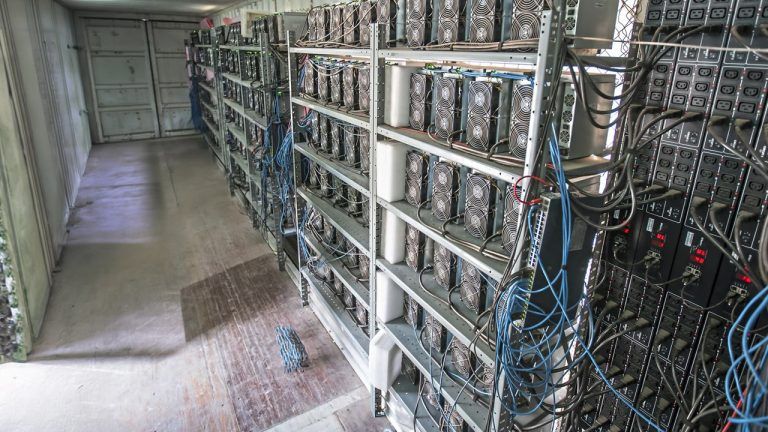 Researchers Murray A. Rudd, Matthew Jones, Daniel Sechrest, Daniel Batten, and Dennis Porter have unveiled a new study showcasing a cutting-edge framework that fuses landfill gas-to-energy (LFGTE) systems with bitcoin mining. This innovative strategy is designed not only to combat methane emissions but also to unlock new economic opportunities. Study Merges Landfill Gas-to-Energy Systems With […]
Researchers Murray A. Rudd, Matthew Jones, Daniel Sechrest, Daniel Batten, and Dennis Porter have unveiled a new study showcasing a cutting-edge framework that fuses landfill gas-to-energy (LFGTE) systems with bitcoin mining. This innovative strategy is designed not only to combat methane emissions but also to unlock new economic opportunities. Study Merges Landfill Gas-to-Energy Systems With […]

According to a United Nations report, Methane gas runoff is “80 times more harmful than CO2 for 20 years after it is released.”
A new peer-reviewed scientific paper, titled An integrated landfill gas-to-energy and Bitcoin mining framework, appearing in the Aug. 29 edition of the Journal of Cleaner Production, demonstrated how Bitcoin (BTC) mining could reduce methane emissions.
The research paper detailed how Bitcoin miners are uniquely positioned to leverage "Landfill Gas to Energy" (LFGTE) systems that capture and convert methane gas from garbage landfills into usable energy—sequestering the greenhouse gas and reducing its harmful effects on the atmosphere.
A breakdown of the energy chain resulting from LFGTE. Source: Science Direct

According to data from SMR Nuclear, nuclear energy plants produce 441,398,880 megawatt-hours of energy throughout their lifetimes.
Former President Donald Trump and New York Governor Kathy Hochul have proposed pivoting to nuclear energy to meet climate goals and provide the vast energy needed for high-performance computing and artificial intelligence.
Governor Hochul believes nuclear energy can help address shortfalls in New York’s ambitious climate agenda, which was first announced in 2019, by positioning the state to meet its 2030 climate goals.
Trump, the 2024 Republican presidential candidate, pitched the idea of shifting to nuclear power in a recent interview with podcast host Shawn Ryan, but for very different reasons. The former President explained to Ryan that America needs to generate massive electricity to power the artificial intelligence sector.
 Iris Energy Limited has announced an increase in its power capacity at the Childress site in Texas from 600 megawatts (MW) to 750 MW. This expansion follows approval from the Electric Reliability Council of Texas (ERCOT) and an amended connection agreement with American Electric Power (AEP). Iris Energy Expands Texas Operations On Wednesday, Iris Energy […]
Iris Energy Limited has announced an increase in its power capacity at the Childress site in Texas from 600 megawatts (MW) to 750 MW. This expansion follows approval from the Electric Reliability Council of Texas (ERCOT) and an amended connection agreement with American Electric Power (AEP). Iris Energy Expands Texas Operations On Wednesday, Iris Energy […]

The pro-crypto senator claimed that Bitcoin mining consumes as much energy as household appliances such as tumble dryers.
On July 23, Senator Cynthia Lummis released a report arguing against the Biden administration’s proposed 30% excise tax on the energy consumed by Bitcoin miners.
The report, titled Powering Down Progress: Why A Bitcoin Mining Tax Hurts America, put the Bitcoin (BTC) mining industry into sharper focus, highlighting the benefits of the critical mining infrastructure to the United States' energy grid.
Lummis cited the Bitcoin Energy and Emissions Sustainability Tracker as evidence that Bitcoin mining is cleaner than is commonly imagined, noting that up to 52.6% of BTC mining might be emissions-free.

Tesla removed Bitcoin payments citing environmental concerns, but Elon Musk pledged to reinstate them if renewable energy use on the network increased.
Four years have passed since Tesla stopped accepting Bitcoin, citing environmental concerns. While the Bitcoin mining industry has reportedly increased its share of renewable energy consumption, Tesla doesn’t appear ready to return to Bitcoin payments anytime soon.
On Feb. 8, 2021, Tesla disclosed a $1.5 billion investment in Bitcoin (BTC) in a filing with the United States Securities and Exchange Commission (SEC).
Tesla CEO Elon Musk also decided to include the cryptocurrency in the company’s treasury and began accepting BTC as a form of payment for the company’s electric vehicles.
 According to Peak Mining, a subsidiary of the German bitcoin mining and infrastructure firm Northern Data, the company has announced the purchase of a 300-megawatt ERCOT-approved site in Corpus Christi, Texas. The site is adjacent to another location acquired by the firm in December 2023. Peak Mining Purchases ERCOT-Approved Texas Site Northern Data’s Peak Mining […]
According to Peak Mining, a subsidiary of the German bitcoin mining and infrastructure firm Northern Data, the company has announced the purchase of a 300-megawatt ERCOT-approved site in Corpus Christi, Texas. The site is adjacent to another location acquired by the firm in December 2023. Peak Mining Purchases ERCOT-Approved Texas Site Northern Data’s Peak Mining […]
The UN scientists evaluated the activities of 76 Bitcoin mining nations during the 2020–2021 period and found that the global Bitcoin mining network consumed 173.42 Terawatt hours of electricity.
A recent study conducted by the United Nations (UN) suggested a direct correlation between the price of Bitcoin (BTC) and the energy needed for mining operations.
The UN scientists evaluated the activities of 76 Bitcoin mining nations during the 2020–2021 period and found that the global Bitcoin mining network consumed 173.42 Terawatt hours of electricity. During this timeframe, the crypto ecosystem was undergoing a bull run, and Bitcoin rallied to mark its all-time high of $69,000. The UN report highlighted:
“A 400% increase in Bitcoin’s price from 2021 to 2022 triggered a 140% increase in the energy consumption of the worldwide Bitcoin mining network.”
At the time, fossil energy sources accounted for 67% of the electricity generated for Bitcoin mining. However, crypto entrepreneurs have taken proactive measures to increase their dependence on green energy.
Hydropower satisfied over 16% of the total electricity demand of the global Bitcoin mining network, nuclear, solar and wind energy sources provided 9%, 2% and 5% respectively.
According to the UN report, the top ten Bitcoin mining nations at the time — China, USA, Kazakhstan, Russia, Malaysia, Canada, Germany, Iran, Ireland, and Singapore — together were responsible for 92–94% of the global carbon, water, and land footprint of Bitcoin.
The global push for greener alternatives to fulfil the grid demand will also help reduce the carbon footprint of Bitcoin and the crypto ecosystem.
Related: Bitcoin mining is becoming more environmentally friendly
Recently, Genesis Digital Assets Limited (GDA), a mining and data center company with over 400 megawatts (MW) of power generation worldwide, opened a new data center in Sweden running 1,900 Bitcoin mining machines, driven by the country’s burgeoning renewable energy surplus.
Christian Anders, founder of BT.CX, told Cointelegraph that Bitcoin mining is not very common due to high energy prices. However, he added:
“Sweden, Finland and Norway have a surplus of energy and negative energy prices from time to time, and primarily renewable energy in the form of hydropower in a remote location which is hard to distribute.”
In parallel, Bitcoin mining equipment manufacturers continue to deliver energy-efficient hardware. At the World Digital Mining Summit (WDMS) on Sept. 22, Bitcoin miners shared their plans to help decarbonize the crypto ecosystem.

Bitmain rolled out its efficiency-focused Antminer S21, while Nazar Khan, Terrawulf’s chief operating officer, highlighted that the roll Bitcoin rig manufacturers play “is locating our Bitcoin mining loads in places where that’s happening and how do we facilitate that decarbonization process.”
Magazine: Ethereum restaking: Blockchain innovation or dangerous house of cards?

Bloomberg Intelligence’s crypto market analyst Jamie Coutts says that Bitcoin (BTC) is pulling off one major achievement that is flying under the radar. Coutts says on the social media platform X that at the same rate that Bitcoin adoption is increasing, its network’s carbon emissions are declining, a rare phenomenon. “And this is where the […]
The post Bloomberg Analyst Reveals Under-the-Radar Bitcoin Achievement That Few Industries Can Claim appeared first on The Daily Hodl.

New developments in the Bitcoin mining space have Hut 8 vice president Sue Ennis convinced that well-positioned miners will thrive after the next BTC halving.
The next Bitcoin halving event is less than nine months away, and the consensus opinion among analysts and investors is that the halving will send Bitcoin’s price to a new all-time high or even above $100,000.
Despite this belief, the absence of fresh inflow to the crypto market, the current macroeconomic headwinds and Bitcoin’s (BTC) recent price action below $30,000 do not inspire much confidence in this theory in the short term.
In a recent interview with Paul Barron, Hut 8 vice president Sue Ennis shared her thoughts on how the Bitcoin price will rise above $100,000 in the next year and how the upcoming halving will impact BTC miners. Hut 8 currently has a balance of 9,152 BTC in reserve, of which 8,305 is unencumbered. The company’s installed ASIC hash rate capacity sits at 2.6 exahashes per second, and Hut 8 mined 44.6 BTC in July.
In the interview, Barron inquired whether rising Bitcoin difficulty for miners could induce a fresh wave of sell pressure against BTC. Citing data from Hashrate Index, Barron observed that spikes in Bitcoin difficulty were followed by drops in BTC’s price.

Barron questioned if miners were selling Bitcoin as a result of the upcoming halving creating a need for more efficient ASICs and whether BTC’s pre- and post-halving price action would not be as bullish as investors expected.
According to Ennis:
“There’s a lot of really unprecedented dynamics that are happening now in the mining space. [...] What’s interesting is hash rate continues to come online despite Bitcoin price trading in a certain band. [...] We’re still seeing hash rate increase.”
Ennis elaborated with:
“What’s changed now is that we’re seeing Bitcoin price come down a little, but hash rate continues to go up. [...] I think what’s really exciting and different is we’re seeing a tremendous amount of new entrants into the global Bitcoin network.”
Ennis referenced six gigawatts of nuclear and renewable energy being generated in the Middle East, and with the region's governments exploring Bitcoin mining as an option, more hash rate is coming online in a way that is somewhat price agnostic. This is drastically different from how publicly traded United States-based and more forward-facing miners operate.
In order to stay afloat after the halving, Ennis suggested that miners need to be in a position to avoid being “single-threaded,” i.e., they need more than one way of earning revenue beyond just mining Bitcoin.
Revenue diversification would include exploring various artificial intelligence (AI) applications, dedicating some warehouse rack space to GPUs for companies specializing in AI training and possibly offering industrial-level ASIC repair services — or even participating in demand-response initiatives with large energy producers and distributors.
Related: September ‘crash’ to $22K? — 5 things to know in Bitcoin this week
Crypto investors have waited years for the launch of a spot Bitcoin exchange-traded fund (ETF), and even with the recent influx of applications, an approval by the U.S. Securities and Exchange Commission remains elusive.
Despite the history of delays and denials, Ennis said that a “spot ETF coming to market, that’s incredibly bullish for the asset class,” but she also cautioned that an approval could create sell pressure on miner equities given that mining stocks have often been used as a proxy investment to Bitcoin.
Regarding the percentage chance of a spot Bitcoin ETF approval by the end of 2023, Ennis said:
“Definitely better than 50. The real reason for my opinion on that is that BlackRock threw its hat in the ring, BlackRock being powerful and the largest asset manager in the world. For them to throw their hat in the ring and say this is what we want and the amount of clout they’ve had in markets in past initiatives has been tremendous. So I think for them to make this call, that is a real bullish signal.”
Regarding a potential target for the Bitcoin price, Ennis said:
“I definitely do think we could see in this next cycle $100,000 cost per Bitcoin, and that’s based on if BTC were to capture even 2 to 5% of gold’s $13 trillion place in institutional portfolios. If Bitcoin were able to capture even 2 to 3% of gold’s market cap, that would be incredibly accretive to the price and push it north of $100,000.”
This article does not contain investment advice or recommendations. Every investment and trading move involves risk, and readers should conduct their own research when making a decision.